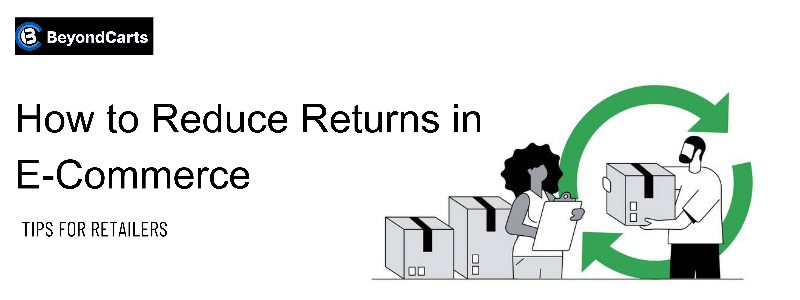
Is Your Return Rate Eating into Your Profits?
In e-commerce, high return rates beyond being an inconvenience, they’re also a costly symptom of deeper issues. With average return rates climbing as high as 30% in some product categories, ask your business strategy: Are you unknowingly encouraging returns? Could small changes in your approach significantly reduce returns rate and improve your bottom line?
As a retailer, every returned item chips away at your profit margins, inflates operational costs, and can even erode trust. Returns cost retailers $761 billion globally in an annual and addressing these return rates head-on cut costs and take a critical step toward building a more sustainable, customer-centred e-commerce model.
This blog dives deep into strategies for reducing returns, with tips and examples that can empower you to keep your customers happy and your profits intact.
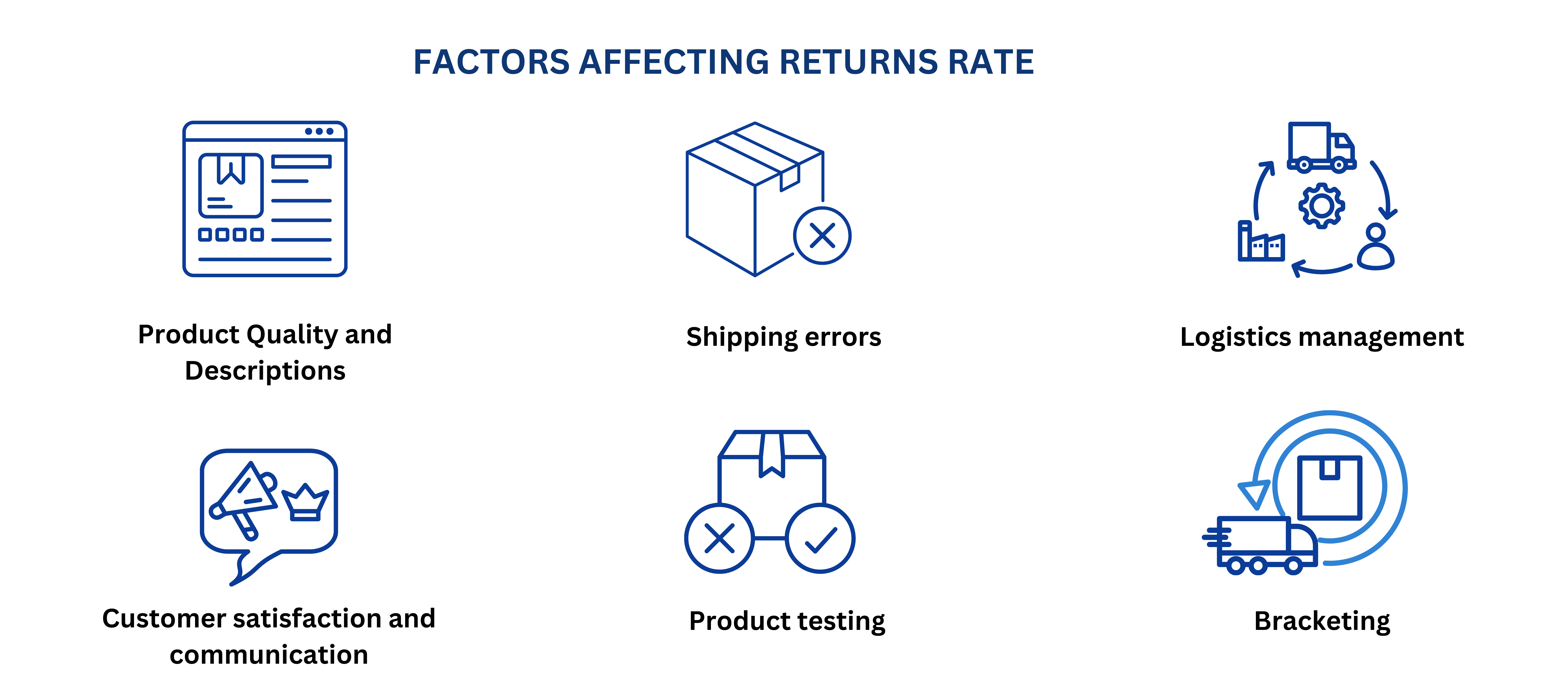
Why Should You Reduce Returns?
Reducing returns in e-commerce is far more than a cost-saving tactic. It's a strategic move that builds brand loyalty, sharpens inventory management, and supports sustainable operations, all while helping retailers meet customer expectations in a highly competitive market. Here’s a closer look at why reducing return rates is essential for long-term success:
- Substantial Financial Impact Beyond Refunds
Returns have a hidden cost well beyond reverse logistics, restocking, and refunds, while its repercussions extend to around 59% of the item’s price when accounting for labour, repackaging, and restocking. Added transaction fees further cut into profit margins, particularly in high-return categories like apparel and electronics.
- Environmental Sustainability
Returns create a substantial environmental footprint, contributing over significant metric tons of CO₂ emissions and pounds of waste annually in the U.S. As eco-conscious shopping rises, 72% of consumers now favour brands committed to sustainability, making return reduction a competitive advantage.
- Retention and Loyalty
Frequent returns hurt customer loyalty. Brands with low return rates enjoy stronger retention, more repeat purchases, and positive customer reviews, making it a core driver of loyalty.
- Inventory Management and Cash Flow Stability
Returns create cash flow and inventory disruptions by tying up capital in unsellable goods. During peak seasons, this strain is magnified, leading to costly inventory mismanagement. Stable return rates support smoother operations and more accurate inventory forecasts potentially supporting the profitability.
- The "Serial Returner" Impact
A small percentage of “serial returners” contribute heavily to return rates, purchasing multiple variations with the intent to return. Reducing this trend helps stabilize inventory and limits high costs associated with excessive returns.
- Reduced “Return Anxiety”
Return anxiety affects significant online shoppers who hesitate to buy for fear of a cumbersome return process. Reliable, quality products encourage confident purchases, reducing return reliance and reinforcing brand trust.
Checkout how BeyondCarts returns labelling transform returns.
In sum, reducing returns supports financial health, brand reputation, and customer satisfaction, creating a lasting advantage for retailers committed to delivering on customer expectations. Here are 7 tips that can help to reduce returns.
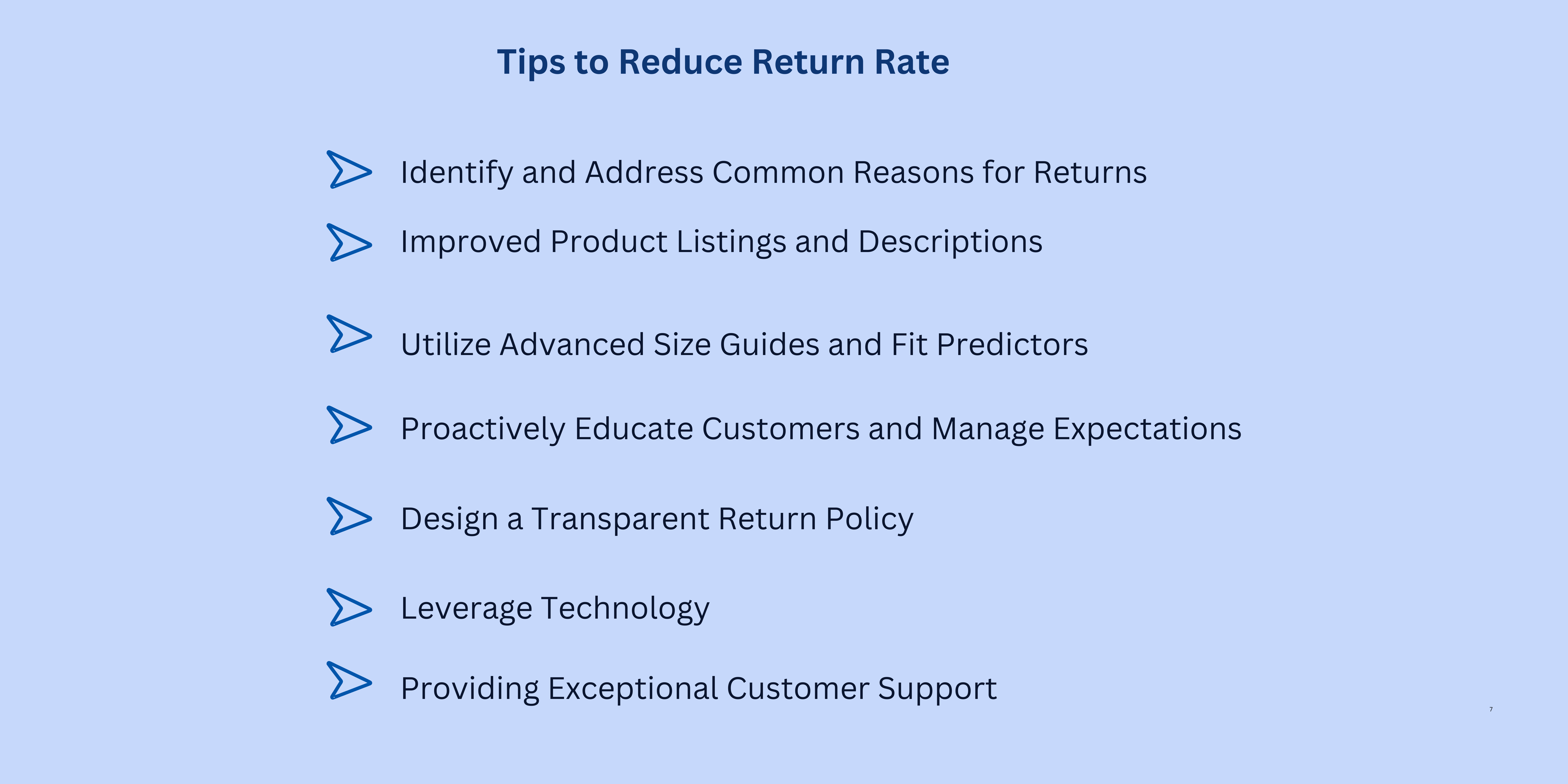
1. Identify and Address Common Reasons for Returns
Understanding why customers return items is the foundation of a successful return-reduction strategy. Instead of seeing returns as an unavoidable loss, view them as feedback to analyse the insights it offers.
- Analyse Return Data: Begin by identifying patterns. Are returns higher for specific product categories, certain times of year, or particular sizes? Leverage analytics tools to track trends and pinpoint root causes, whether it’s sizing issues, unmet expectations, or shipping damages.
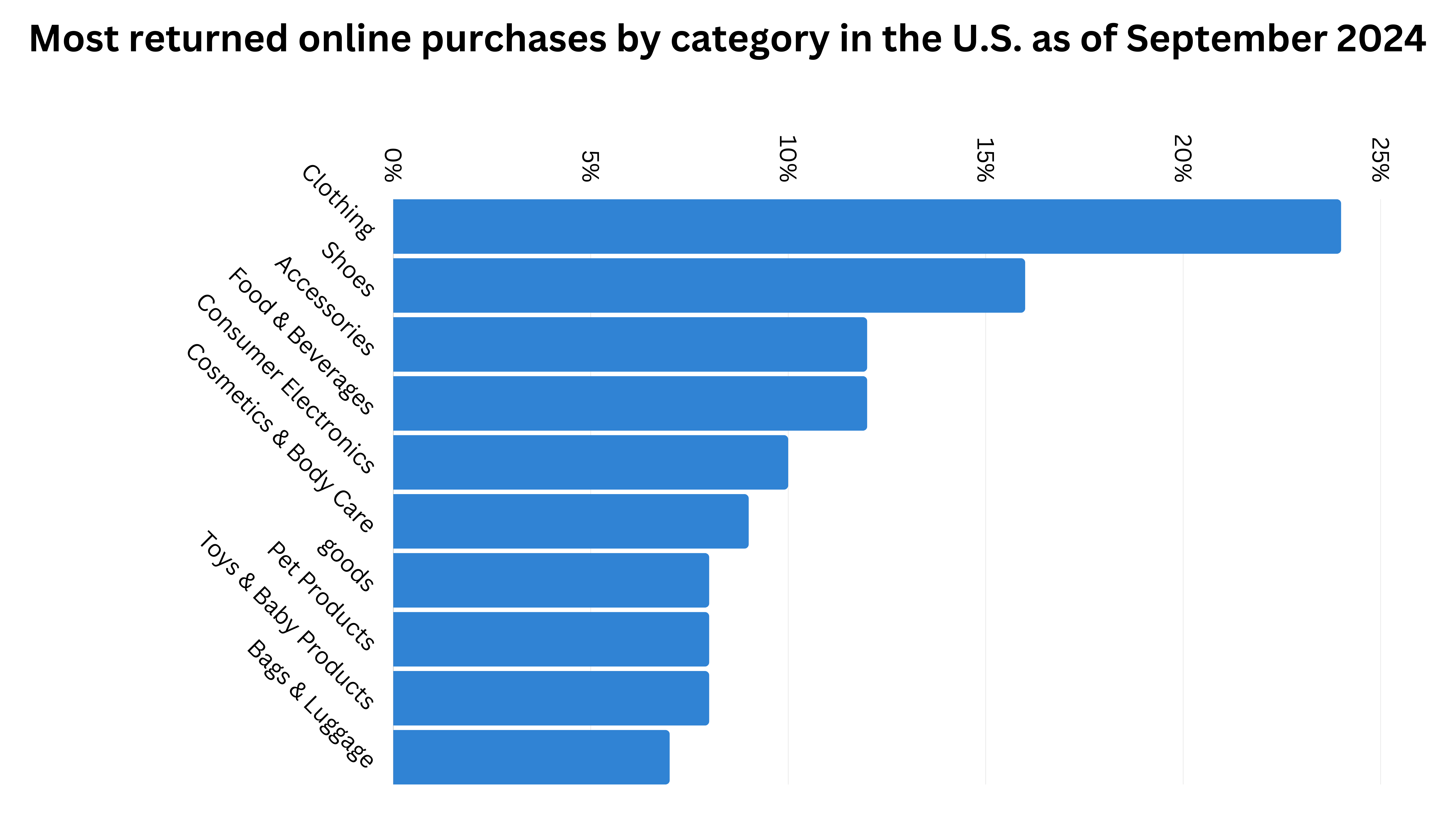
- Collect Customer Feedback: Use surveys, product reviews, or post-return interviews to understand the customer’s experience. For instance, if customers frequently return items due to colour discrepancies, you can address this by adjusting your product imagery or descriptions.
One major apparel retailer significantly reduced return by analysing customer feedback, discovering that sizing and fit were common issues. In response, they enhanced their sizing guides and provided more detailed product descriptions, resulting in a 5% reduction in return rates within a few months.
Insightful return data enables e-commerce retailers to make precise adjustments, addressing root issues that can lead to lasting improvements.
2. Improved Product Listings and Descriptions
Your product page should be a transparent preview of what the customer will receive. Ambiguous or incomplete descriptions fuel returns, as customers may feel misled when the product doesn’t meet expectations.
- High-Quality Images and Videos: Display products from multiple angles and include zoomable, high-resolution images. Customers are less likely to return items when they have access to clear, multi-angle visuals before their purchases.
- Detailed Product Descriptions: Go beyond basic information to offer dimensions, weight, and material descriptions. This transparency helps set accurate expectations. For clothing, mention details like fabric composition and care instructions, while for electronics, highlight compatibility and specifications.
- Video Demonstrations: If applicable, show the product in action to clarify size, colour, and fit, especially for high-return categories like electronics and furniture.
For example, an online furniture retailer might include videos demonstrating the assembly process and showing the furniture from multiple angles in a room setting. This allows customers to better understand dimensions and aesthetics, reducing returns due to unmet expectations.
Clear, detailed listings don’t just sell products; they prevent returns by ensuring customers know exactly what they’re getting.
3. Utilize Advanced Size Guides and Fit Predictors
Inconsistent sizing is one of the top reasons for returns in apparel, but innovative sizing tools can help bridge this gap.
- Interactive and Detailed Size Charts: Standard sizing charts may not account for different body types. Instead, provide guides based on specific measurements (height, waist size) or offer recommendations for different body shapes to minimize confusion.
- Virtual Try-On and Fit Prediction Tools: Technology like virtual fitting rooms allows customers to see how clothes will fit on their own body shape, reducing uncertainty. Tools like Virtusize or True Fit help customers gauge the right fit, decreasing the likelihood of returns due to size or fit issues.
For example, Zara app uses a “What’s My Size?” feature that suggests sizes based on previous purchases and body type, and it resulted in reduced returns due to incorrect sizing.
When customers feel confident about their sizing choices, they’re less likely to make impulse buys and more likely to keep what they buy.
4. Proactively Educate Customers and Manage Expectations
Often, customers return items due to misunderstandings or incorrect assumptions. Educating customers upfront about the product’s features, care, and usage can make a substantial difference.
- Transparent Product Care Instructions: For categories like apparel and electronics, incorrect care can lead to damaged products and dissatisfaction. Provide easy-to-follow care instructions, whether it’s avoiding hot water washes or using specific cleaning products.
- Post-Purchase Communication: Stay connected after the sale. Send personalized emails with tips on product care, usage guidelines, or maintenance instructions, helping customers feel more supported and valued.
- Educational Content: Offer blog posts, how-to videos, or FAQ pages explaining product features, ideal use cases, or common issues. For instance, mattress company Casper educates customers on breaking in their mattress, which reduces “comfort” returns by setting clear expectations.
Proactive customer education builds trust and lowers returns by ensuring customers are prepared and informed.
5. Design a Transparent Return Policy
A transparent return policy is essential, but it should encourage thoughtful purchasing while reassuring customers.
- Clear, User-Friendly Policies: Include clear language that explains timeframes, conditions, and the process of returns. Avoid fine print, as it can deter purchases or create dissatisfaction if customers feel misled.
- Encourage Alternatives to Returns: Offering exchanges or store credit instead of refunds can retain revenue and satisfy customers without the need for a full return. Few businesses encourage exchanges or in-store returns, which helps maintain customer satisfaction while reducing return logistics costs.
The in-store return option creates an opportunity to convert the return into an exchange or even another purchase.
Providing customers with flexible, straightforward return policies builds loyalty while setting realistic expectations, ultimately reducing return rates.
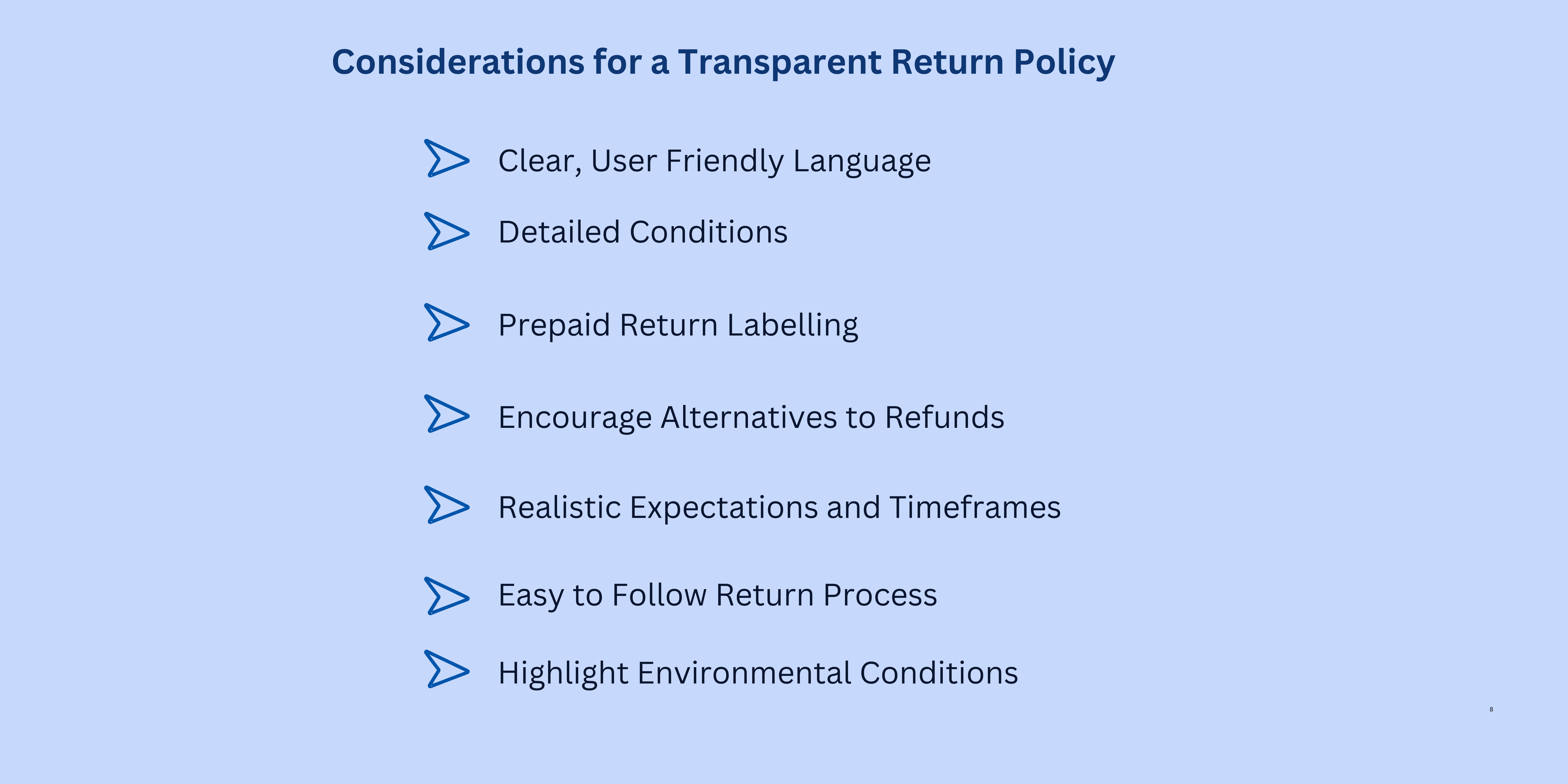
To learn more about how to boost your e-commerce ROI with smart return policies.
6. Leverage Technology
Technology can significantly reduce return rates by bridging the gap between online shopping limitations and customer expectations.
- Augmented Reality (AR) Visualization Tools: AR technology allows customers to visualize products in their own space. For example, IKEA’s app lets users see furniture in their rooms through AR, helping prevent returns due to size or aesthetic mismatches.
- Artificial Intelligence (AI) for Personalized Recommendations: AI-powered recommendation engines suggest items tailored to a customer’s style, size, and preferences. This personalized shopping experience minimizes the risk of mismatches, reducing return rates.
- For instance, beauty brand Sephora uses AR mirrors in-store and online, allowing customers to “try on” products virtually, which reduces returns by ensuring customers choose the right shades and styles.
7. Providing Exceptional Customer Support
Great customer support is an essential line of defence against returns. A helpful, responsive support team can prevent misunderstandings, resolve issues before they escalate, and improve the customer experience. According to research, nearly 33% of product returns can be traced back to insufficient product support or misunderstanding. By improving customer support, retailers can directly reduce return rates.
- Responsive Pre-Purchase Support: Offering live chat, a comprehensive FAQ, and accessible contact options lets customers clarify details before making a purchase. This level of support helps prevent returns due to unfulfilled expectations.
- Post-Sale Customer Service: Offering assistance post-purchase, such as troubleshooting or setup help, can prevent returns driven by difficulties in product use.
Empowering your support team with knowledge about products and return-related issues not only improves customer satisfaction but also builds trust and reduces the need for returns.
Take a Proactive Approach to Managing Returns Now
Reducing returns is achievable with a proactive, customer-centered approach built on transparency, education, and smart technology. By addressing common challenges, enhancing product listings, implementing sizing tools, and delivering exceptional customer support, e-commerce retailers can transform their return process into a growth opportunity.
Are you ready to lower your return rates and foster lasting customer loyalty? Start applying these proven strategies today and connect with our experts at BeyondCarts to discover how tailored return logistic solutions can drive profitability for your business.
Let’s turn returns into a powerful asset, partner with BeyondCarts and unlock the full potential of optimized return logistics.


